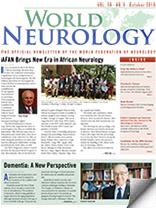By Mohamed Albakaye, MD
The exploration of neuromuscular training, especially through the use of electromyography (EMG) in confirming a diagnosis and in classifying neuropathies, is essential to the neurological training course.
Thus, the World Federation of Neurology (WFN) took the initiative to open a training center in EMG at the Hospital of Specialties, Rabat, Morocco, to educate young neurologists training in Africa. This initiative has been widely appreciated by neurologists in sub-Saharan Africa.
I had the privilege of being the first African neurologist to benefit from this training. In this report, I will share my experiences as an intern, including the different activities I led.
My 10-month training period, under the supervision of Prof. Mustapha El Alaoui Faris, ran from September 2014 to June 2015. I worked in the neurophysiology department of the Hospital of Specialties in Rabat, a public university hospital accredited by the WFN to train African neurologists since 2013. The department, headed by Prof. Reda Ouazzani, is the only accredited center in Morocco for mentoring young neurologists in EMG and electroencephalography (EEG). The department has six instructors for three units, which have the modern equipment needed to explore neuromuscular diseases and epilepsy:
- EMG
- EEG and video-EEG
- Evoked potential
The first part of my internship was devoted to EMG and the examination of patients with neuromuscular diseases. The second part focused on EEG, video-EEG and the examination of patients with epilepsy. A teacher supervised all of these activities.
During my stay in the EMG unit, I attended all of the EMG activities, examined patients admitted for EMG and those requiring EMG based on diagnosis guidelines, and proposed EMG protocols, which were validated by the teacher in charge of the EMG session.
The last two months of my internship were spent in the EEG and video-EEG unit, where I learned different editing techniques, interpretation of EEG during wakefulness and sleep tracings in adults and children.
I also attended multidisciplinary medical consultations of patients with myopathies, led by Prof. Nezha Birouk, which allowed me to explain diagnositic approaches, treatment and prevention of myopathies.
Through my participation in various multidisciplinary staff meetings, I participated in regular Thursday afternoon staff meetings, which gave instructors from all of the neurophysiology departments the opportunity to share interesting cases from the previous week. I made presentations about clinical cases and discussed the contribution of the wave F in EMG during these meetings. Each Friday morning, one of the neurological teams hosted a conference, and I gave a presentation about a case of drug-resistant epilepsy in adult during one of these.
I as well presented a clinical case and had an interactive discussion with staff from the Moroccan Foundation Against Neurological Diseases.
Through this internship, I had the opportunity to attend several neurology seminars and congresses:
- Seminar of the Moroccan Society of Neurology on Headache and Dizziness, Tangier, Morocco
- Journée de Neurologie de Langue Française, Marseille, France
- Seminar on Movement Disorders, Casablanca
- Seminar of the Moroccan Society of Neuropsychology on Frontotemporal Dementia, Rabat
- Meeting of the Moroccan League Against Epilepsy on Frontal Lobe Epilepsy, Rabat
- Seminar of the Moroccan Foundation Against Neurological Diseases on Neuro-rehabilitation, Mohammedia, Morocco
- Maghrebian Neurological Congress, Agadir, Morocco. During the conference, I had the opportunity to meet Prof. Wolfgang Grisold.
The training was a good opportunity to publish articles, while guiding me toward scientific research. My first article, “Frontal Cerebral Cavernoma,” about a case of drug-resistant partial epilepsy was accepted as a poster in the JNLF Congress. The abstract was published in Revue Neurologique 171, Suppl 1 (April 2015): A 97-98.
My second scientific work during this internship was a retrospective study of the epidemiological, clinical, paraclinical, therapeutic and evolutionary roles in 40 cases of hemiconvulsion-hemiplegia epilepsy syndrome occurring in the department of neurophysiology at the Hospital of Specialties from 2005 to 2015. The study is being written for possible publication.
My neurophysiology training gave me a great opportunity to fill my shortcomings in this discipline. I am pleased with how Prof. El Alaoui and Prof. Ouazzani were so transparent and available to me.
My recommendations to WFN are to:
- Ensure the continuity of this initiative.
- Provide EMG continuing education support to allow us to consolidate our gains.
- Determine the young neurologists who will benefit from this training, ultimately encouraging them to train others in other countries in a spirit of solidarity
I want to thank everyone who contributed to the success of my internship in Rabat. I particularly would like to express my sincere thanks to Prof. El Alaoui Faris for his advice and encouraging the success of my training. I sincerely thank WFN for giving me this continuing education opportunity. I thank Prof. Ouazzani for his teaching during my time in service. My thanks also goes to Prof. Birouk for her willingness to initiate us into the best practices of EMG. I cannot forget to warmly thank warmly Professors H. Belaïdi, B. Kably, F. Lahjouji and L. Errguig for their availability and their teachings. Finally, I deeply thank my family in Mali, who supported me in my studies long ago. I owe them what I am today.
